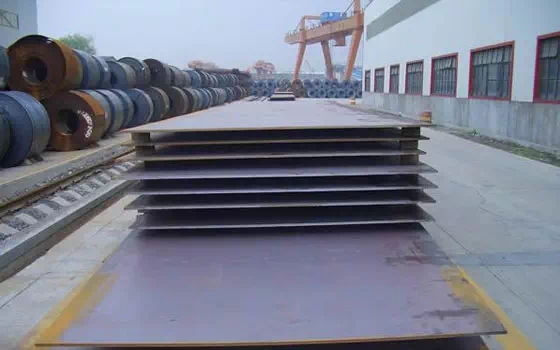Coated steel plate is also known as coated steel plate. It is a general term for products coated with Sn, Zn, Al,
Cr, Pb-Sn alloys, organic coatings and plastics on the surface of low carbon steel plates with good deep
drawing properties. Commonly used coated (plated) steel plates include tin-plated plate, wuxi steel
plate, galvanized steel plate, aluminum-plated steel plate, lead-tin alloy steel plate and organic coated steel
plate.
In the thickness of 0.1 ~ 0.32mm steel plate surface plated with pure tin products. Tin-coated sheet has bright surface, corrosion resistance, deep drawing lubricity, good soldering ability, and can carry out exquisite printing and finishing. It is widely used in food canning industry and light production.
Galvanizing is an economical and effective method to prevent steel corrosion, and the thickness of galvanized steel is generally 0.35 ~ 3mm. There are two kinds of galvanizing methods: hot plating and electroplating. The thickness of the hot plated zinc layer is generally 60 ~ 300g/m2 (single-sided), which is used for parts requiring strong corrosion resistance. The zinc layer of electroplating is 10 ~ 50g/m2 (single side), which is mostly used for painted parts or unpainted parts with low corrosion resistance. Hot plating method according to pre-treatment method flux method and protective gas reduction method. The flux process is to acid wash the annealed steel plate, remove the oxide on the surface, and then pass through the flux tank containing ZnCl2 and NH4Cl, and then enter the molten zinc tank to galvanize. Protective gas reduction method is widely used for continuous hot dip galvanizing of strip steel. The strip steel first passes through the flame heating furnace to burn off the residual oil on the surface, and at the same time, the iron oxide film is formed on the surface. Then enter the reduction annealing furnace containing H2 and N2 mixed gas and heat to 710 ~ 920℃, so that the iron oxide film is reduced into sponge iron. After the surface purification and activated strip steel is cooled to a temperature slightly higher than that of molten zinc, it is entered into a zinc pan at 450 ~ 460 ° C, and the zinc layer thickness is controlled by an air knife. Finally, it was passivated by chromate solution to improve the resistance to white rust.

Alkaline method and acid method are divided according to the plating solution used. The alkaline solution has high price, environmental pollution, low production efficiency and poor coating quality, so it is not used in fact. The main components of acidic plating solution are ZnSO4·7H2O, NH4Cl and Al2(SO4)3·18H2O. With pure zinc as the anode and strip steel as the cathode, under the action of current, zinc anode plate is dissolved into Zn2+ into the plating solution, and Zn2+ is reduced into metal zinc at the cathode and deposited on the strip surface. The coating is treated with a mixture of phosphate and chromate, which can improve the finishing property, and the surface of the electrogalvanized steel plate is bright and smooth, which was mainly used in the automotive industry in the past. In recent years, the scope of application has expanded to the electrical industry and other aspects, which has promoted the development of electrogalvanized plate industry. In the 1970s, single-sided galvanized sheets were also developed.
Color coated steel plate is a composite metal plate with galvanized steel plate or cold rolled steel plate as the matrix, and is coated with various protective and decorative coatings after surface treatment, also known as "color organic coated steel plate". The structural layer of color coated steel plate from inside to outside is cold-rolled plate, galvanized layer, chemical conversion layer, primary coating (primer), fine coating (front and back paint). This kind of plate surface color novel, strong adhesion, corrosion resistance and decorative good, and good processing performance, can be shear, bending, drilling, riveting, curling and so on. Commonly used coatings are divided into inorganic coatings, organic coatings and composite coatings.
The color coated steel plate is mainly used as the wall panel of the external wall of the building, and the direct use of it to form the wall needs to be a heat insulation layer; In addition, it can also be used as roofing board, corrugated board, waterproof and anti-air penetration board, corrosion resistant equipment and components as well as furniture, automobile shell, water baffle and so on.
property
(1) Pollution resistance. The color coated steel plate has a strong resistance to pollution. The ketchup, lipstick, coffee beverage, cooking oil, etc. are smeared on the surface of the polyester coating, placed 24 hours later, cleaned and dried with washing liquid, and the surface luster and color do not change.
(2) High temperature resistance. The color coated steel plate was continuously heated in the oven at 120℃ for 90 h, and the gloss and color of the coating did not change significantly.
(3) Low temperature resistance. When the color coated steel plate is placed at -54℃ for 24 h, the bending and impact resistance of the coating have no obvious change.
(4) boiling water resistance. After soaking all kinds of coating products in boiling water for 60 minutes, the surface luster and color did not change, and there was no foaming, softening, expansion and other phenomena.
评论
发表评论